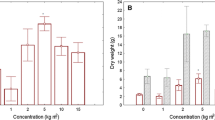Abstract
The impact of the Common Osier (Salix viminalis L.) root system on number (CFU) of heterotrophic bacteria and their production in a soil-willow filter was examined. The Osier rhizosphere was found to be suitable habitat for growth of the examined microbial group, and the root system stimulated development of heterotrophic bacteria. The rhizosphere bacteria to control soil bacteria (R:C) ratio oscillated between 2.48 and 2.75 depending on the location of sample collection. The highest abundance of bacteria as well as highest bacterial production was observed at location I, near sewage discharge onto the plot. There was a significant positive correlation between the number of heterotrophic bacteria and the bacterial production.


Similar content being viewed by others
References
Armstrong J, Armstrong W (1990) Pathways and mechanisms of oxygen transport in Phragmites australis. In: Cooper PF, Findlater BC (eds) Constructed wetlands in water pollution control. Pergamon Press, Oxford, pp 529–533
Bååth E (1994) Thymidine and leucine incorporation in soil bacteria with different cell size. Microbiol Ecol 27:267–278
Barabasz W, Albińska D, Chmiel MJ, Barabasz J (2006) Microbiocenotical changes originated in energetic willow rhizosphere under influence use of sewage sludge as fertilization. Acta Agr Silv ser Agr 49:55–74
Bednarek R, Dziadowiec H, Pokojska U, Prusinkiewicz Z (2005) Ecology and Soil Science Research. PWN Warszawa ss. 344
Bodelier PLE, Libochaut JA, Bliom CWPM, Laanbroek HJ (1996) Dynamics of nitrification and denitrification in root-oxygenated sediments and adaptation of ammonia-oxidazing bacteria to low-oxygen or anoxic habitats. Appl Environ Microbiol 62:4100–4107
Brix H (1994) Use of constructed wetlands in water pollution control: historical development, present status, and future perspectives. Water Sci Technol 30:209–223
Christensen H, Ronn R, Ekelund F, Christensen S (1995) Bacterial production determined by [3H] thymidine incorporation in field rhizospheres as evaluated by comparison to rhizodeposition. Soil Biol Biochem 27:93–99
Dahm H (1984) Generic composition and physiological and cultural properties of heterotrophic bacteria isolated from soil, rhizosphere, mycorrhizosphere of pine (Pinus sylvestris L.). Acta Microbiol Pol 33(2):147–156
Decamp O, Warren A (2001) Investigation of E. coli removal in various designs of subsurface flow wetlands used for wastewater treatment. Ecol Eng 14:293–299
Filipkowska Z (2003) Sanitary and bacteriological aspects of sewage treatment. Acta Microbiol Pol 52:57–66
Fuhrman JA, Azam F (1982) Thymidine incorporation as measure of heterotrophic bacterioplankton in marine surface waters. Evaluation and field results. Mar Biol 66:109–120
Helfield JM, Diamond ML (1997) Use of constructed wetlands for urban stream restoration: a critical analysis. Environ Manage 3:329–341
Hench KR, Bissonnette GK, Sexstone AJ, Coleman JG, Garbutt K, Skousen JG (2003) Fate of physical, chemical, and microbial contaminants in domestic wastewater following treatment by small constructed wetlands. Water Res 37:921–927
Kadlec RH, Knight RL (1996) Treatment wetlands. CRC Press, Boca Raton, Florida, p 893
Kickuth R (1970) Oekochemische Leistungen hoherer Pflanzen. Naturwissenschaften 57:55–61
Kickuth R (1975) Sind hohere Pflanzen bei der Gewasserreinigung wirksam? Forum Umwelthygiene 6:165–167
Kowalik P, Obarska–Pępkowiak H (1997) Water and sewage treatment in hydrophyte purification systems. Municipal Review 66:41–48
Lalke–Porczyk E, Donderski W (2005) The role of bacteria growing on the root system of the common reed (Phragmites australis [Cav.] Trin. ex Steudel) in the metabolism of organic compounds. Pol J Environ Stud 43:57–64
Moriarty DJW, Boon PI, Hansen JA, Hunt WG, Poiner IR, Pollard PC, Skyring GW, White DC (1985) Microbial biomass and productivity in seagrass beds. Geomicrobiol J 1:21–51
Niewolak S, Korzeniewska E, Filipkowska Z (2005) Seasonal changes in the numbers of nitrogen cycle bacteria in the water, soil and plants of the wetlands near Olsztyn. Acta UNC Limn Pr XXV 113:105–122
Ottova V, Balcarova J, Vymazal J (1997) Microbial characteristics of constructed wetlands. Water Sci Technol 35:117–123
Raczkowska-Błach E, Różycki H, Strzelczyk E (1995) Decomposition of indoleacetic acid (IAA) in soil and by bacterial strains isolated from soil and from the root zone of Scots pine (Pinus sylvestris L.). Microbiol Res 150:265–270
Różycki H, Strzelczyk E (2004) Utilization of various carbon and energy sources by bacteria associated with roots of various plants and with sporocarps of ectomycorrhizal fungi––in vitro studies. Acta Agr Silv ser Agr 42:409–418
Seidel K (1966) Biologischer Seenschutz. In: Pflanzen als Wasserfilter. Foederation Europaischer Gewasserschutz symposium 76:357–369
Strzelczyk E, Gorlach K, Różycki H (1990) Chitinolytic and proteolytic activity of streptomycetes isolated from root–free soil, rhizosphere and mycorrhizosphere of pine (Pinus sylvestris L.). Biol Fertil Soils 9:268–272
Swiontek Brzezinska M, Lalke-Porczyk E, Donderski W (2007) The bacteriological and sanitary state of sewage in an on-site willow wastewater treatment facility. Pol J Nat Sci 22(2):284–293
Verhoeven JTA, Meuleman AFM (1999) Wetlands for wastewater treatment: opportunities and limitations. Ecol Eng 12:5–12
Vymazal J (1995) Algae and element cycling in wetlands. Lewis Publishers, Chelsea Michigen, p 698
Vymazal J, Brix H, Cooper PF, Green MB, Haberl R (1998) Constructed wetlands for wastewater treatment in Europe. The Netherlands, Leiden Backhuys Publishers, p 368
Wielgosz E, Szember A, Pryciak A (2004) The influence of selected plants on the occurrence of complexes of soil microbes. Annales UMCM Sec E 59.4:1679–1688
Wolverton J, Mc Donald RC (1976) Water hyacinths (Eichhornia crassipes) for removing chemical and photographic pollutants from laboratory wastewaters––NASA Technical Memorandum TM-X-72731: 1–9
Acknowledgment
This paper was financed from the funds of research in years 2006–2008 as a research project.
Author information
Authors and Affiliations
Corresponding author
Rights and permissions
About this article
Cite this article
Lalke–Porczyk, E., Brzezinska, M.S. & Donderski, W. Influence of the Root System of the Common Osier (Salix viminalis L.) on Abundance of Heterotrophic Bacteria in the Willow Sewage Treatment System. Curr Microbiol 58, 571–577 (2009). https://doi.org/10.1007/s00284-009-9373-3
Received:
Revised:
Accepted:
Published:
Issue Date:
DOI: https://doi.org/10.1007/s00284-009-9373-3




